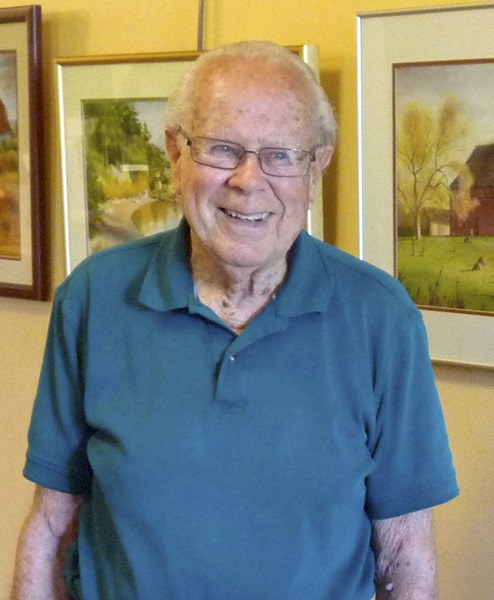By Gretchen Wing
People are almost nowhere to be found in Bob Proctor’s paintings, but anyone who prefers outdoors to indoors, or rural to urban, will feel right at home in his company.
Between the scenes of old barns lining the hallway, and the gentle Salish seascapes gracing the kitchen, Bob’s house seems to have far more windows than it actually does. The effect goes beyond peaceful, to pastoral.
It would be easy to see Bob’s paintings as a reaction to a life lived mostly in a big city, but Bob doesn’t see it that way. First of all, Glendale, Calif., where he grew up and spent the bulk of his working years, was not then the megalopolis it is today.
And secondly, as Bob puts it, “painting is just relaxing to me.” He’s not trying to make any statement; he’s simply utilizing a practiced skill to capture appealing scenes. And since losing Earleen, his wife of 66 years, last June, Bob relies on his art more than ever.
 Bob and Earleen – “her dad was named Earl,” Bob explains met on a blind date after the Second World War. Bob had enlisted in the Air Corps and spent a year flying bombing missions over occupied China, a year which he says, in his understated fashion, he “did not particularly like.” (Luckily for Bob, he came into the war fairly late, when the Japanese forces were weakening, so he never had to deal with attacks from their fighter planes.) Mutual friends set him and Earleen up, and they “took to each other like ducks to water.” A year later, in 1948, they were married, spending several years as a couple before starting a family.
Bob and Earleen – “her dad was named Earl,” Bob explains met on a blind date after the Second World War. Bob had enlisted in the Air Corps and spent a year flying bombing missions over occupied China, a year which he says, in his understated fashion, he “did not particularly like.” (Luckily for Bob, he came into the war fairly late, when the Japanese forces were weakening, so he never had to deal with attacks from their fighter planes.) Mutual friends set him and Earleen up, and they “took to each other like ducks to water.” A year later, in 1948, they were married, spending several years as a couple before starting a family.
Bob’s artistic roots begin way down in his childhood; “I always liked to draw,” he says. Immediately after the war, Bob spent three years in art school, looking for a way to turn his natural inclinations into a career.
He found one as a photo re-toucher, wielding airbrushes in an artistic fashion. “It’s actually quite a skill,” Bob notes, adding that his was the last generation able to make a career practicing that skill, which has since given way to computers.
After his retirement, when he took some more art classes, Bob enriched his understanding of perspective, line and color, expanding his skill set and enabling the move from photographic retoucher to creative watercolorist.
Since the scenes on Bob’s walls are almost exclusively northwestern, clearly his big artistic shift did not occur in California.
While his job originally took Bob and Earleen to Chicago for some years, they raised their kids in California, where Bob had grown up. Sunny Glendale, and camping trips to the Sierras, provided ample outdoorsiness in those days for their son and two daughters.
By the time Bob retired, though, the family had grown and spread itself far and wide, and the Proctors opted to move closer to their kids – and, later, grandchildren – turning themselves into northwesterners in the process.
Their first move took them to Salem, Ore., which they loved. Some years later, the couple moved to Mt. Vernon, then Arlington, and finally, eight years ago, here to Lopez, at the invitation of their daughter, Joyce Lyster.
Both Bob and Earleen reveled in the south end peacefulness. Regular trips up to the Senior Center for lunch provided sufficient socializing; they were generally content to watch the deer or swans out their windows, and spend time with family. Bob, of course, paints. Earleen’s “art” was more cooking-oriented, but, Bob says, “She was an excellent critic of my work. She would always tell me, ‘I think that part’s too dark,’ and things like that.”
His lovely landscapes, Bob says, are not derived solely from talent: “Painting’s like anything else: it’s a matter of practice, of study.” Especially in broader ocean or mountain scenes, Bob says, “I strive for distance.” He’s referring to the techniques he uses, using lighter paints at the furthest point of perspective, but the statement could be taken more figuratively.
Looking through the collection in his studio, Bob points out that the white in his paintings is not paint, but the paper itself, left alone to utilize its absence of color exactly as it is. Something about that technique, so practical, so subtle and yet so striking, seems perfectly suited to this modest artist, husband, father, grandfather and great-grandfather, finding peace and beauty right where it is.




